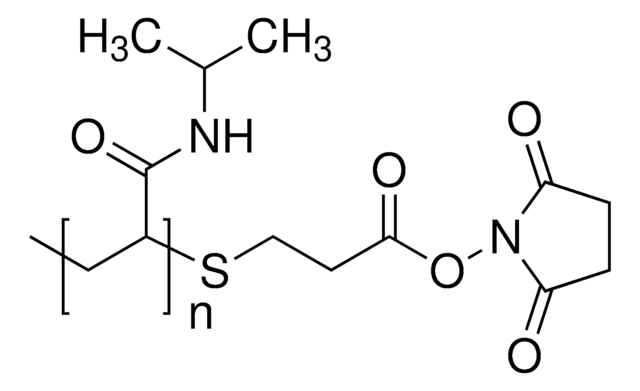904740
Amine-poly(ethylene glycol)-b-poly(ε-caprolactone)
PEG average Mn 5,000, PCL average Mn 5,000
Sign Into View Organizational & Contract Pricing
All Photos(1)
Synonym(s):
Amine PEG-PCL diblock copolymer, Carboxylic acid-PEG-PCL, PEG-b-PCL, PEG-PCL
Linear Formula:
C5H12NOS[C2H4O]n[C6H10O2]mH
UNSPSC Code:
12352116
Recommended Products
form
powder or solid
mol wt
PCL average Mn 5,000
PEG average Mn 5,000
color
white to off-white
PDI
≤1.3 (by GPC)
storage temp.
−20°C
Application
Amine-poly(ethylene glycol)-b-poly(ε-caprolactone) is a functionalized, amphiphilic, diblock copolymer composed of a hydrophilic PEG block and a hydrophobic PCL block. These biodegradable, biocompatible polymers can self-assemble to form nanoparticles, such as micelles and polymersomes, in both aqueous and non-aqueous media. Due to these properties, these polymers are widely used in polymeric nanoparticle formulation to achieve controlled and targeted delivery of therapeutic agents (e.g. APIs, genetic material, peptides, vaccines, and antibiotics). Additionally, well-defined nanoparticles with tunable size and properties can be prepared by altering the molecular weight ratios between hydrophilic and hydrophobic blocks, as well as by controlling formulation parameters. The amine functional group on the PEG chain enables rapid and facile surface functionalization, allowing for these materials to be used in applications such as targeted drug delivery.
WGK
WGK 3
Flash Point(F)
Not applicable
Flash Point(C)
Not applicable
Regulatory Information
新产品
Certificates of Analysis (COA)
Search for Certificates of Analysis (COA) by entering the products Lot/Batch Number. Lot and Batch Numbers can be found on a product’s label following the words ‘Lot’ or ‘Batch’.
Already Own This Product?
Find documentation for the products that you have recently purchased in the Document Library.
Xiaoqiang Yang et al.
Journal of biomedical materials research. Part A, 86(1), 48-60 (2007-10-18)
To overcome multidrug resistance (MDR) existing in tumor chemotherapy, polymeric micelles encoded with folic acid on the micelle surface were prepared with the encapsulation of a potent MDR modulator, FG020326. The micelles were fabricated from diblock copolymers of poly(ethylene glycol)
Cem Varan et al.
Beilstein journal of nanotechnology, 8, 1446-1456 (2017-09-14)
Background: Brain tumors are the most common tumors among adolescents. Although some chemotherapeutics are known to be effective against brain tumors based on cell culture studies, the same effect is not observed in clinical trials. For this reason, the development
Articles
Professor Robert K. Prud’homme introduces flash nanoprecipitation (FNP) for nanoparticle fabrication, which is a scalable, rapid mixing process for nanoparticle formulations.
Our team of scientists has experience in all areas of research including Life Science, Material Science, Chemical Synthesis, Chromatography, Analytical and many others.
Contact Technical Service







